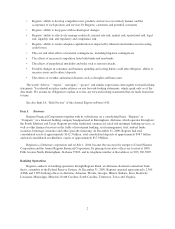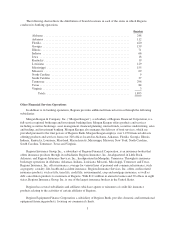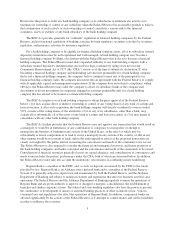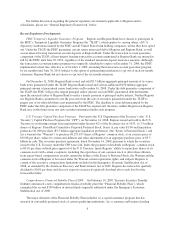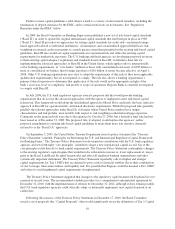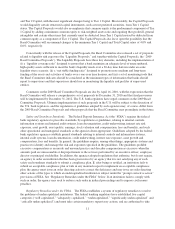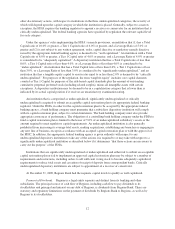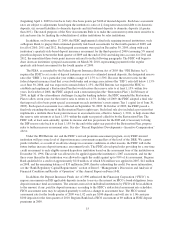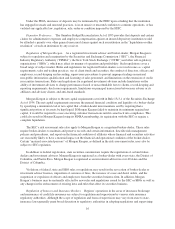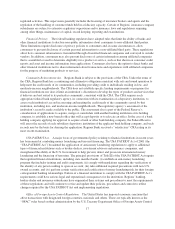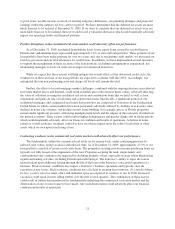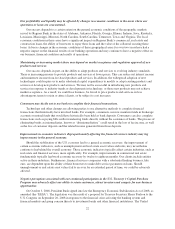Regions Bank 2009 Annual Report Download - page 26
Download and view the complete annual report
Please find page 26 of the 2009 Regions Bank annual report below. You can navigate through the pages in the report by either clicking on the pages listed below, or by using the keyword search tool below to find specific information within the annual report.other discretionary actions, with respect to institutions in the three undercapitalized categories, the severity of
which will depend upon the capital category in which the institution is placed. Generally, subject to a narrow
exception, the FDIA requires the banking regulator to appoint a receiver or conservator for an institution that is
critically undercapitalized. The federal banking agencies have specified by regulation the relevant capital level
for each category.
Under the agencies’ rules implementing the FDIA’s remedy provisions, an institution that (1) has a Total
Capital ratio of 10.0% or greater, a Tier 1 Capital ratio of 6.0% or greater, and a Leverage Ratio of 5.0% or
greater and (2) is not subject to any written agreement, order, capital directive or regulatory remedy directive
issued by the appropriate federal banking agency is deemed to be “well capitalized.” An institution with a Total
Capital ratio of 8.0% or greater, a Tier 1 Capital ratio of 4.0% or greater, and a Leverage Ratio of 4.0% or greater
is considered to be “adequately capitalized.” A depository institution that has a Total Capital ratio of less than
8.0%, a Tier 1 Capital ratio of less than 4.0%, or a Leverage Ratio of less than 4.0% is considered to be
“undercapitalized.” An institution that has a Total Capital ratio of less than 6.0%, a Tier 1 Capital ratio of less
than 3.0%, or a Leverage Ratio of less than 3.0% is considered to be “significantly undercapitalized,” and an
institution that has a tangible equity capital to assets ratio equal to or less than 2.0% is deemed to be “critically
undercapitalized.” For purposes of the regulation, the term “tangible equity” includes core capital elements
counted as Tier 1 Capital for purposes of the risk-based capital standards plus the amount of outstanding
cumulative perpetual preferred stock (including related surplus), minus all intangible assets with certain
exceptions. A depository institution may be deemed to be in a capitalization category that is lower than is
indicated by its actual capital position if it receives an unsatisfactory examination rating.
An institution that is categorized as undercapitalized, significantly undercapitalized or critically
undercapitalized is required to submit an acceptable capital restoration plan to its appropriate federal banking
regulator. Under the FDIA, in order for the capital restoration plan to be accepted by the appropriate federal
banking agency, a bank holding company must guarantee that a subsidiary depository institution will comply
with its capital restoration plan, subject to certain limitations. The bank holding company must also provide
appropriate assurances of performance. The obligation of a controlling bank holding company under the FDIA to
fund a capital restoration plan is limited to the lesser of 5.0% of an undercapitalized subsidiary’s assets or the
amount required to meet regulatory capital requirements. An undercapitalized institution is also generally
prohibited from increasing its average total assets, making acquisitions, establishing any branches or engaging in
any new line of business, except in accordance with an accepted capital restoration plan or with the approval of
the FDIC. In addition, the appropriate federal banking agency is given authority with respect to any
undercapitalized depository institution to take any of the actions it is required to or may take with respect to a
significantly undercapitalized institution as described below if it determines “that those actions are necessary to
carry out the purpose” of the FDIA.
Institutions that are significantly undercapitalized or undercapitalized and either fail to submit an acceptable
capital restoration plan or fail to implement an approved capital restoration plan may be subject to a number of
requirements and restrictions, including orders to sell sufficient voting stock to become adequately capitalized,
requirements to reduce total assets and cessation of receipt of deposits from correspondent banks. Critically
undercapitalized depository institutions are subject to appointment of a receiver or conservator.
At December 31, 2009, Regions Bank had the requisite capital levels to qualify as well capitalized.
Payment of Dividends. Regions is a legal entity separate and distinct from its banking and other
subsidiaries. The principal source of cash flow of Regions, including cash flow to pay dividends to its
stockholders and principal and interest on any debt of Regions, is dividends from Regions Bank. There are
statutory and regulatory limitations on the payment of dividends by Regions Bank to Regions, as well as by
Regions to its stockholders.
12


